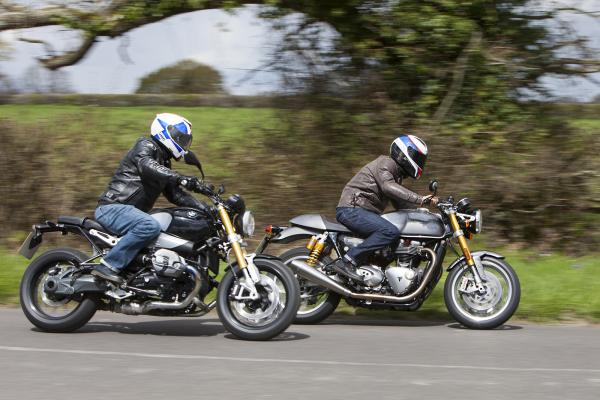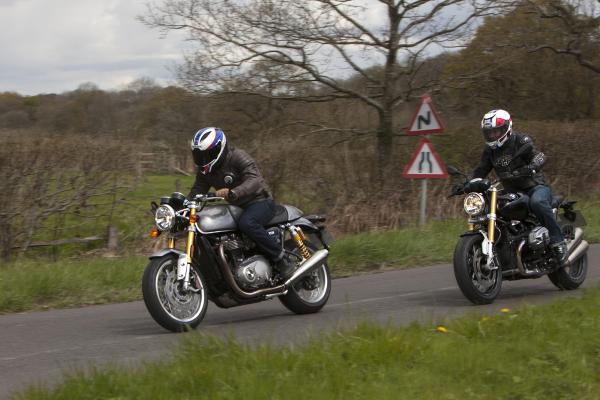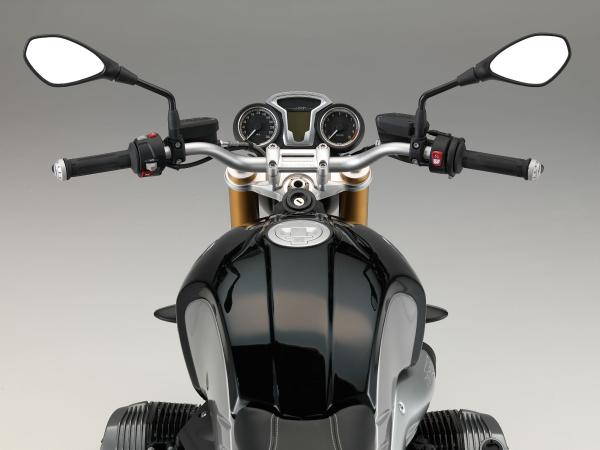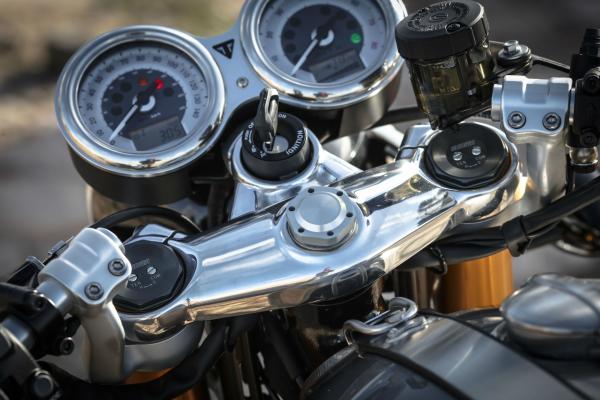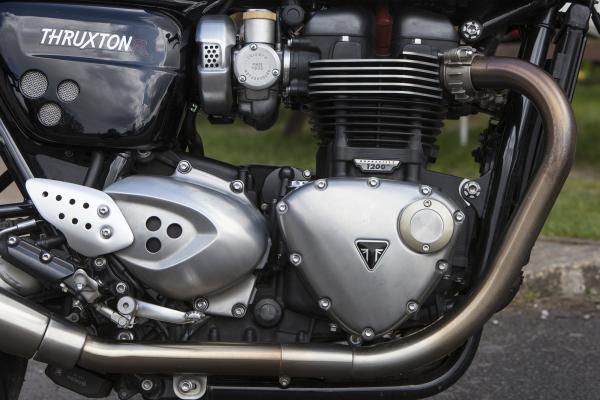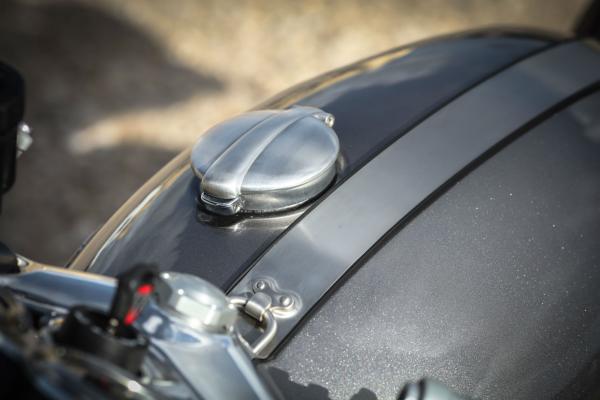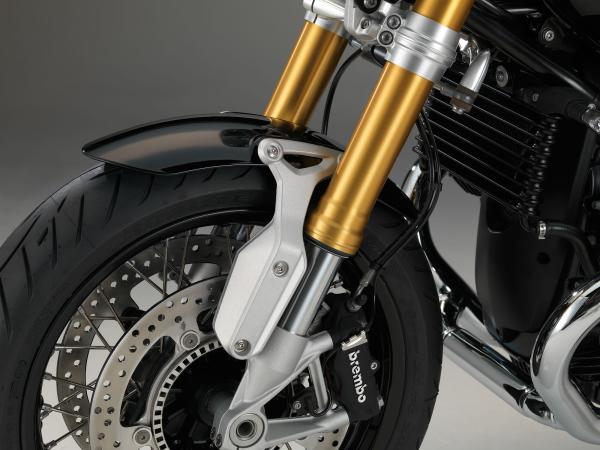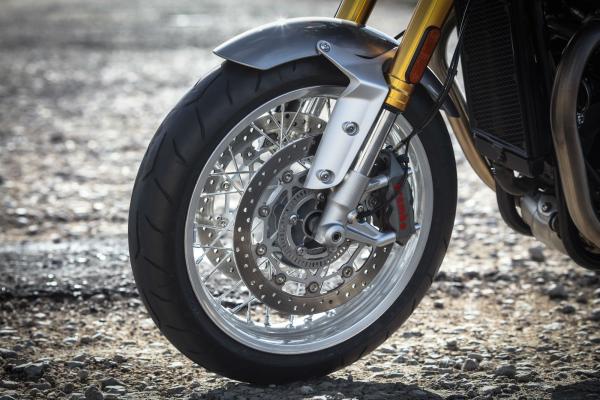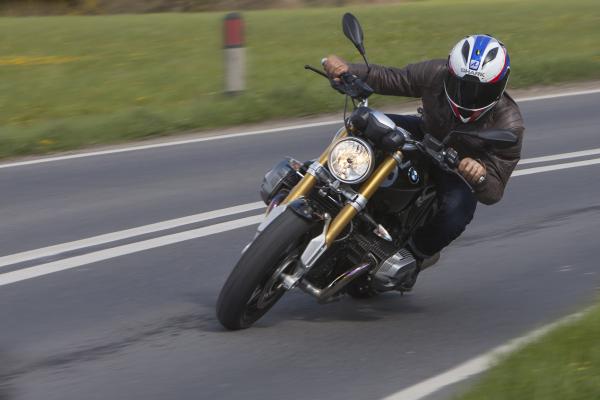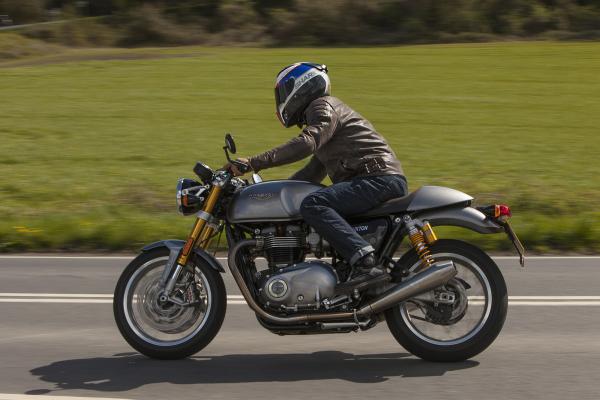Back-to-back test: Triumph Thruxton R vs BMW R nineT
One of these machines raises expectations of performance from a heritage motorcycle. The other is even better.

Member for
54 years 8 monthsBMW’S R nineT is the motorcycle that showed traditional styling and character didn’t have to mean traditional levels of technical competence. That a machine could roll off a production with classic appeal, looking like it might be the work of custom house, and with cutting-edge brakes, handling and suspension. That an engine could have modern power, torque and thrills along with traditional character. It seemed the perfect blend of the traditional and modern.
And then Triumph launched the new Thruxton R, flagship of its new-for-2016 Bonneville family. With two years between the models, and the new-wave heritage bike scene exploding around an ageing Bonneville line-up, no one can accuse Triumph of being too quick off the mark. But we didn’t mind when we saw it. If BMW’s boxer engine has some traditional clout then the Bonneville name has at least as much, especially in the UK market, and the Thruxton R delivered. It united journalists in appreciation of it when it was launched in March this year, immediately prompting speculation over which would win in a back-to-back test with the R nineT. We took both bikes out for a blast through some of West Sussex’s finest roads. But before we even got that far, something stood out about the R nineT. Parked next to the Thuxton R in our lock-up, it suddenly didn’t look so traditional. The black plastic clocks next the Thruxton R’s chrome and silver ones. The black tear-drop mirrors next to the Triumph’s bar-end ones on split stalks. The BMW’s straight bar and clamps where the Thruxton R has clip-ons and a top yoke so polished you can see your face in it. The BMW's single white shock next to the Triumph’s gold-coloured twin piggy-back Öhlins.
And the filler caps: Triumph’s Monza-style one versus the BMW’s, well, modern one, albeit aluminium. Even the engines, with BMW’s painted cylinder heads next to the brushed cases of the Triumph. The R nineT seems to have been comprehensively out-traditioned.
And not just in looks. The R nineT has the power and torque advantage, with 110hp and 87.8lbft compared to 97hp and 82.6lbft, and it’s immediately apparent. It feels stronger in the mid-range. It’s enough to let you ration it and still go fast, where the Thuxton R goads you into using everything it has all the time. It also delivers a strong burst of mid-range torque followed by a just-as-pleasing top-end. The red line is lower than the BMW’s, at 7,000 instead of 8,500, but on the Triumph you go there at every opportunity where the R nineT is more conducive to lazily short-shifting. It’s clear which is fastest. In a roll-on third gear acceleration test from 30mph, the Triumph briefly took the lead before the BMW passed it and was never seen again. With closely matched high-spec suspension and brakes, it would be difficult for the Triumph to make up the advantage in corners. But just because a bike is the fastest doesn’t mean it engages you to ride it the fastest. If I were to get caught speeding on one of these machines, because I just have to go everywhere on it as fast as it will get me there, I think it would be the Thruxton R. It’s partly the character of the engine. The BMW’s has rumble but the Triumph’s has more. The British bike has the cheek to sound more air-cooled, even though it’s the one of the two that isn’t. Both are loud but the Thruxton R is more angry. It makes the boxer sound and feel modern, sanitised, maybe even over-powered. The Thuxton R more convincingly evokes the past. Characterful though the boxer-twin is, sending rotational forces through the chassis at standstill, it suffers by comparison in the same way the BMW’s styling does; it’s been out-heritaged. It’s not just the engine that compels you to ride the Triumph faster. It’s the riding position and geometry too. The Triumph's clip-ons have you leaning forward, not as much as a sports bike but enough to evoke the spirit of a café racer. It focuses you more than R nineT, which is upright, more like a naked bike. You can’t sit leaning on your arms and think about what you’re going to have for tea. It creates a better sense of connection with the front tyre, and of the Pirelli Diablo Rosso Corsa's connection with the road. The Thruxton R also feels the quicker-steering of the two the moment you get on it. That might partly be down to the smaller rear tyre, a 160-section to the R nineT’s 180. Both bikes have immensely powerful brakes, with a similar arrangement of four-pot Brembo radial monobloc calipers on twin front discs, but the Triumph give’s a better sense of precision control. You’re never in any doubt of the ferocious bite available but the lever is like a fine-tuner, delivering exactly what you want and no more. There is one arena in which the R nineT is more traditional than the Thruxton R: that of electronics. But I’m not sure this is in the BMW’s favour.
Both bikes of course come with ABS. On the R nineT that is the end of the list of electronic rider aids. On the Thruxton R, the list goes on to include traction control, which can be switched off, and three riding modes – Sport, Road and Rain – offering varying degrees of torque in response to a given throttle input. It’s not a deal-breaker on bikes like these. When I first rode the R nineT, I liked it because of its simplicity, and I was hardly ever out of ‘Sport’ on the Thruxton R anyway. But the Triumph’s electronics are not overcomplicated or distracting. You can ignore them if you want, as I did, and so they seem only another thing in the Thruxton R’s favour.
Along with the suspension, which is fully-adjustable at both ends on the Thruxton R while the BMW has non-adjustable forks and a shock adjustable for pre-load and rebound damping. And the price: from £11,900 for the BMW or £11,700 for the Triumph. I can’t highlight superior elements of the Thruxton R’s styling without also acknowledging where the R nineT does it better: aluminium. Lots of it, and all of it real.
The R nineT’s aluminium tank with brushed sides should not be overlooked. Those ostentatious intake ducts are also real aluminium, along with the front mudguard bracket. The Thruxton R has a very similar pair of brackets attaching its front mudguard to the forks – but they are plastic made to look like aluminium. How did that get approved? Both bikes come with irritations. The BMW has an indicator switch which doesn’t move enough, so you’re never sure it’s registered your input. The Triumph will only start with the clutch in. At one point I released the clutch, thinking I’d started it in neutral, only to find it was in first. It lurched forward and stalled. This is why bikes should not require you to pull the clutch in before starting in neutral. The Triumph also had a more worrying tendency for the engine to die instead of settling at idle speed. It happened to the bike I rode on the launch, leaving me drifting through a junction with no power. It happened several times to the bike we borrowed for this test, sometimes while riding.
Both machines are comfortable but the Thuxton R becomes less so over time because of the extra weight it puts on your arms. Both are limited in their capacity for filtering through tight spaces in busy city traffic, the Thuxton R because its bar-mounted mirrors clash with those of cars and the R nineT because its cylinders stick out like a pair of forward-mounted panniers. You have to keep an eye on them when weaving between stationary cars. And for all its beautiful detail, the Thruxton R didn’t seem to attract as much attention from onlookers as the R nineT did. Visordown’s Kane Dalton borrowed the Triumph to ride home through London and, like me, was surprised to find that no one really seemed to notice it. They’re all philistines. The BMW is still a terrific heritage bike but the bar has moved. The Thruxton R does it better.
Second rider Simon Greenacre gives his verdict on the Thruxton R vs R nineT: I like the attention that riding a bike can attract; loud exhausts, beautiful shapes and bright colours are just a few reasons why I choose two wheels over a brown Hyundai. For me, that’s what the BMW R nineT and Triumph Thruxton R are all about; through a combination of looks and noise, they get heads turning. I was immediately sold on the R nineT’s deep, burbling exhaust noise. In fact, it sounds so good from the factory that after my first journey I had to double check it didn’t have a fruity aftermarket exhaust. There’s presence in the R nineT’s form too – it’s stocky, muscular and well proportioned, and it made me feel the same when I was riding it. And that physicality is matched by the power on tap. Its looks strike me as effortless; I don’t think it’s clamouring to be a café racer or modern retro bike – it’s just right as it is. That is until the Triumph Thruxton R arrives. It’s beautiful. Even though I’d had a look at the Thruxton R at various shows, I don’t think I'd ever really taken in how special it is. Being handed the key to one made me sit up and take a lot of notice, and there’s a lot to notice – from the luscious paint to the stainless steel exhausts, to the detail in the engine and then on to the clocks and top yoke. But it’s not just for looking at – this bike rewards when you get a move on. It also sounds thunderous and burbling. The power delivery is smooth and the engine game for a thrashing. It isn’t perfect – I think it’s tendency to cut out is a fuelling issue – but it feels sharper than the R nineT, turning more quickly and with greater precision. As you play out a fantasy of being a racer from the 1950s, it’ll let you carve up your favourite A-road with aplomb, and there’s a reason it comes on Pirelli Diablo Rosso Corsas. The twin Brembo four-pot front brakes are immense. At first I thought they were too much for this bike but the power comes with so much feel and control that I grew to love them. During the time we had these two on test, I’d always try and end up with the key to the Triumph. I can’t think of a more decisive verdict than that.
WATCH OUR TRIUMPH THRUXTON R VS BMW R NINET VIDEO REVIEW
Model tested Triumph Thruxton R and BMW R nineT
Price Thruxton R: £11,700 plus tax and registration. R nineT: From £11,900
Engine Thruxton R: 1200cc liquid-cooled eight-valve SOHC parallel-twin. R nineT: Air/oil-cooled DOHC boxer twin
Power Thruxton R: 97hp @ 6,750rpm. R nineT: 110hp @ 7,550rpm
Torque Thruxton R: 82.6lbft @ 4,950rpm. R nineT: 87.8lbft @ 6,000rpm
Weight Thruxton R: 203kg dry. R nineT: 222kg fully fuelled
Frame Thruxton R: Tubular steel cradle, aluminium swing-arm. R nineT: Tubular steel with load-bearing engine, removable pillion sub-frame for single-seat option
Suspension Thruxton R: Showa 43mm USD big piston forks, fully adjustable with 120mm travel. Fully adjustable Öhlins twin shocks with piggyback reservoir and 120mm rear wheel travel. R nineT: USD 46mm non-adjustable fork with 120mm of travel, single rear shock adjustable for pre-load and rebound damping, 120mm rear wheel travel
Brakes Thruxton R: Twin 310mm floating front discs and Brembo four-piston radial monobloc calipers. Single 220mm rear disc with two-piston Nissin caliper, ABS as standard. R nineT: Twin 320mm floating front discs with Brembo four-piston radial monobloc calipers. Single 265mm rear disc with two-piston floating caliper, ABS as standard T
Tyres Thruxton R: Pirelli Diablo Rosso Corsas, 120/70-17 front, 160/60-17 rear. R nineT: Metzeler Roadtec Z8s, 120/70-17 front, 180/55-17 rear
Seat height Thruxton R: 810mm. R nineT: 785mm
Fuel capacity Thruxton R: 14.5 litres. R nineT: 18 litres
Fuel economy measured on test, mix of roads Thruxton R: 56mpg. R nineT: 48mpg
Colours Thruxton R: Red, silver, matt black. R nineT: 'Black Storm Metallic'
